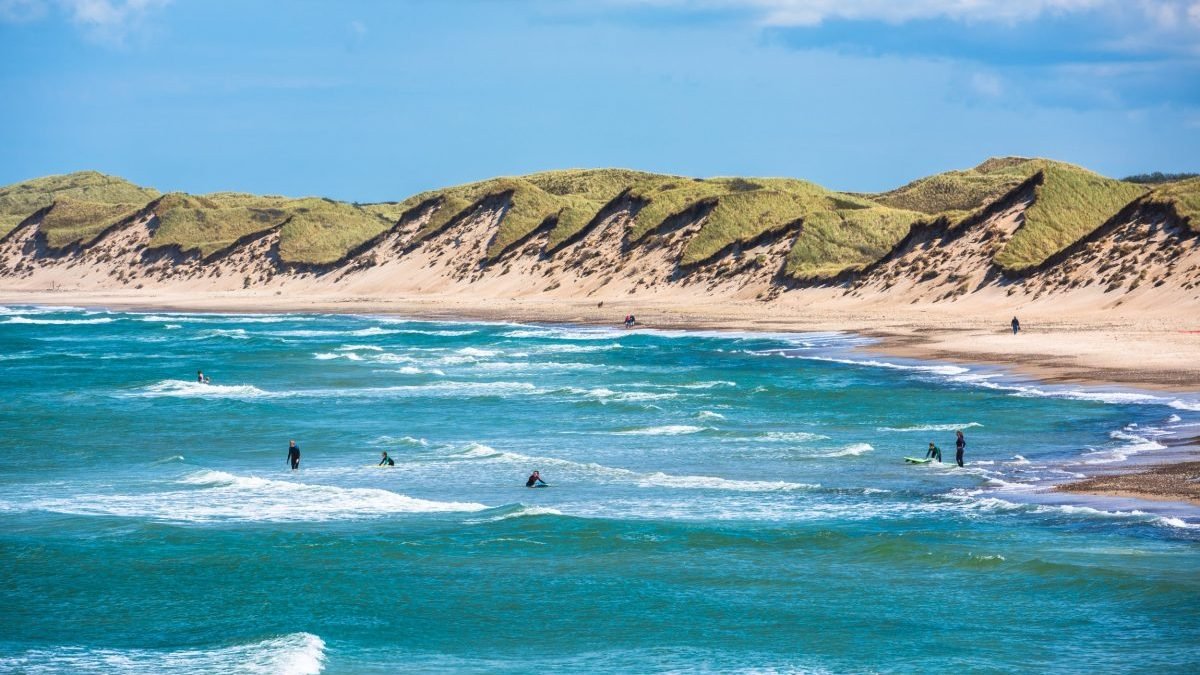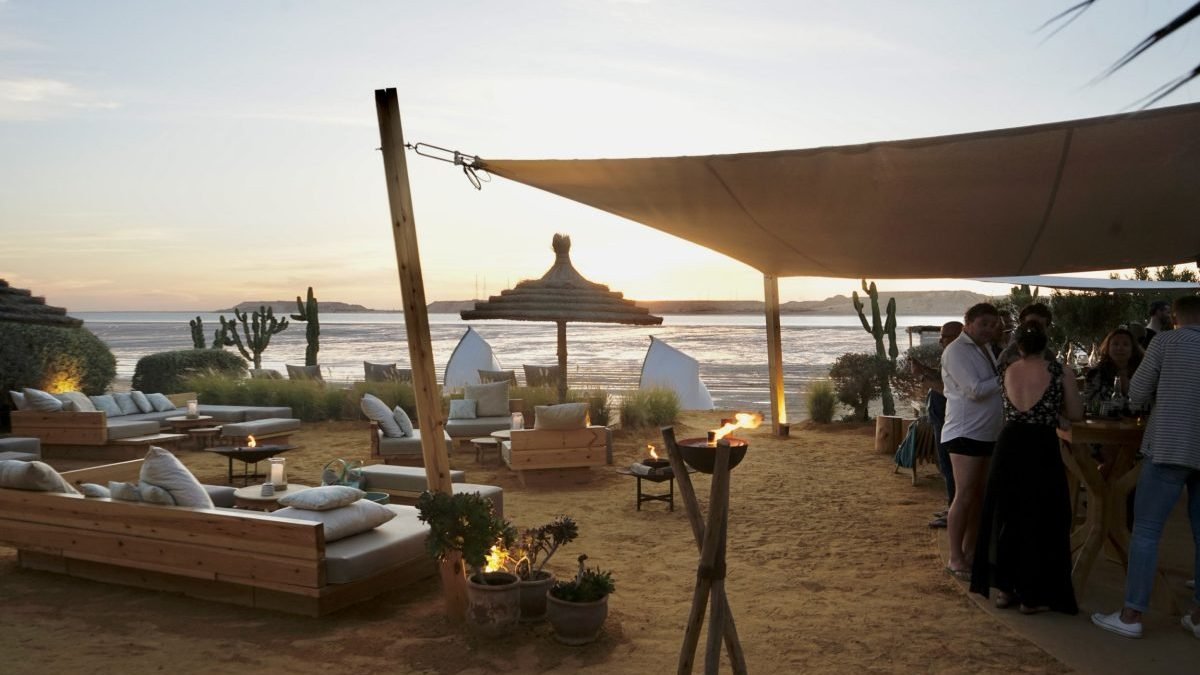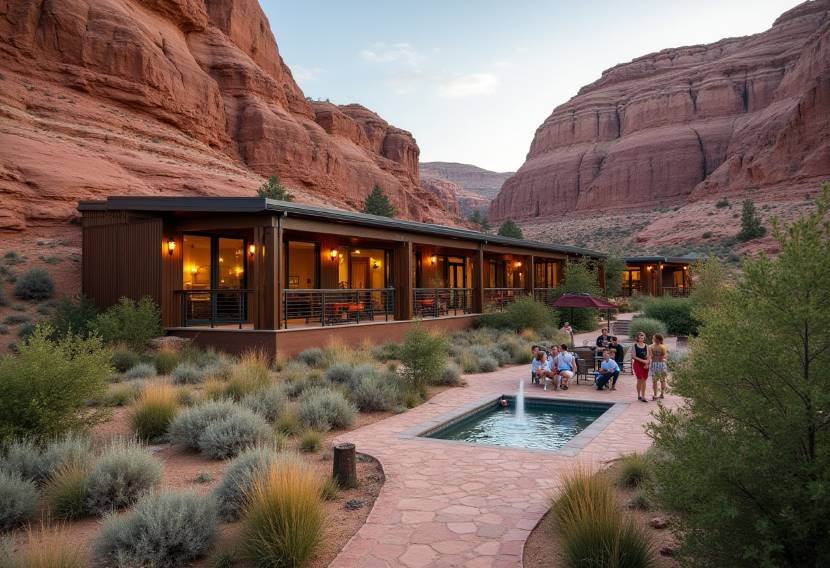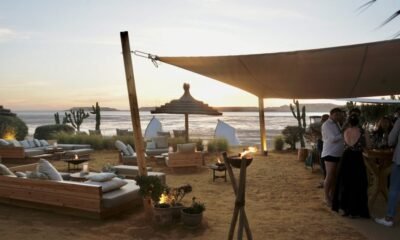Ways to Travel
Seven tranquil, mild beach holidays without the crowds

With temperatures heading towards 40°C in parts of the Mediterranean basin, the Nordics and the Baltics offer alternative coastal escapes
Summer holidays are on the horizon, but with overtourism and extreme heatwaves causing concern in Southern Europe, many UK travellers are looking to escape the hot spots in favour of cooler and less crowded places.
According to eDreams Odigeo, parent company of online travel brands Opodo and eDreams, interest in destinations with temperate summer climates is on the rise. UK users’ searches for trips to Sweden in July and August were up by 27 per cent year on year in the first five months of 2025. Norway, Finland and Denmark all had increases of between 11 and 16 per cent. Intrepid Travel, meanwhile, has reported a rise of 22 per cent in bookings for Iceland and 41 per cent for Estonia this summer.
Despite this interest, there are still plenty of beaches on which to enjoy milder weather away from the hordes – as long as you’re happy to put in the miles.
Gateway to the Danish wilderness – Vorupør, Denmark
In north-west Jutland, at the heart of Thy National Park, Denmark’s most extensive wilderness, Vorupør is a beach town unsullied by development. Traditional fishing boats, or “cutters”, are still hauled ashore by winch, adding a dash of nautical heritage to the charming village’s strip of pale sand. The beach is one of few in Denmark to have a tidal swimming pool with a wheelchair ramp and is part of the surf-centric “Cold Hawaii” coast.
Vorupør might be lively by the standards of lonesome Thy region, but it is blissfully quiet compared with most Mediterranean beach resorts. And don’t miss the national park’s ethereal landscape of heath-topped dunes, stretching about 34 miles beyond the village.
From Copenhagen, travel by rail to Sjørring and onward by bus to Vorupør, or drive the 256 miles from the capital or 110 miles from Billund airport.
Boutique hotel Vø Drop Inn, one of the closest accommodation options to the beach, has doubles from £96, including breakfast, vodropinn.dk.
Edge of the archipelago – Naantali, Finland
With its historic centre of 300-year-old wooden houses, Naantali is an engaging introduction to the Archipelago Sea, a tract of the Baltic peppered by the world’s largest archipelago. One of Finland’s oldest towns and original holiday resorts, Naantali has been nicknamed the “Sunshine Town of Finland”, thanks to the area’s comparatively clement weather (by Finnish standards) – summer might bring highs of around 20°C.
Take a boat trip out to some of the 50,000 or so islands or visit Moominworld, a theme park dedicated to Tove Jansson’s beloved characters. And – of course – hit the beach.
Several enticing options lie close to town, including popular Nunnalahti, a gently-shelving strip of sand near the bridge to Moominworld. Another less-crowded possibility is Kailon uimaranta (Kailo Beach), a tree-backed slice of sand on Kailo, the island hosting Moominworld, but outside the Moominworld paid attraction.
From Helsinki, it’s either a 115-mile drive or take the train to Turku and then a bus to Naantali. Nunnalahti and Kailon uimapaikka beaches are accessed from Nunnakatu, around a mile north-west of central Naantali.
Doubles at Naantali Spa Hotel, on a headland with a sandy beach, start at £154, naantalispa.fi.
Unesco-listed dunes – Curonian Spit, Lithuania
There was a time when the quickly shifting dunes of the Curonian Spit would routinely bury its settlements, but in the 19th century, savvy locals planted pine forests, stabilising the ground and further enhancing the region’s beauty. This 61-mile, beach-rimmed band of land, shared between Lithuania and Russia, is today Unesco-protected and still hosts the world’s highest moving dunes.
The place to base yourself is undoubtedly the smart, artsy Lithuanian resort town of Nida. Its Blue Flag beach, part of which is naturist, is often described as the best stretch of sand in the Baltics.
Nida was a base for many turn-of-the 20th-century Expressionist painters and writers, including Thomas Mann, but it is also defined by the colourful pennants that decorate many buildings. Plus, it hosts several festivals showcasing music, literature and cinema – including a celebration of jazz and a Thomas Mann Festival, both held in July.
Nida is the start of the Baltic Coastal Hiking Route, which also passes through Peraküla (see below).
From Lithuania’s second city Kaunas, it’s a 166-mile drive to Nida, or take the train to Klaipeda and bus from there. The best strip of beach is a mile and a quarter north-west of central Nida.
Prie Mariu is a small half-timbered hotel with its own beach on the lagoon. Doubles from £59, priemariunida.lt.
Scandinavia’s best beach bar – Stokkøya, Norway
It’s a long and winding road out to the island of Stokkøya – even from the nearest city, Trondheim, 150 miles to the south. But beach lovers who make it will not be disappointed. Hosnasand has perhaps the finest beach bar in all the Nordics, near its northern end.
Hosnasand itself, a tawny sandy bay on Stokkøya’s west shore, shelves gently into waters backed by high green hills. Restaurant Strandbaren’s floor-to-ceiling glass and stepped terrace up from the beach mean you can enjoy a meal of local fish with sensational sea views.
From Trondheim, it’s just over three hours’ drive to Stokkøya (connected by bridge). Stokkøya Strandhotell in Hosnasand is an eco-chic option with beach-view hotel rooms, tents and motorhome pitches. Double rooms from NOK 1,950 (£145) B&B, stokkoy.no.
Royal retreat – Öland, Sweden
This narrow, gangly, bridge-connected island off Sweden’s south-east coast is a legendary holiday destination for Swedes, but receives few foreign visitors.
Around Böda village in the north-east, Böda Sand is one of the country’s longest beaches, with 12-and-a-half miles of white sand and shallow sparkling water that will fulfil your Caribbean beach fantasies for a fraction of the cost and effort.
Plus, Öland enjoys one of Sweden’s loveliest climates, with average maximum temperatures during July and August in the early 20°Cs; the northern part around Böda generally gets the island’s balmiest weather.
This part of the island is a former kronopark – a Swedish royal hunting ground comprising swaths of sandy conifer forest ribboned by
hiking trails.
Elsewhere, the island is packed with history, from Iron Age remains to a baroque castle, near which sits the Swedish royal family’s summer residence.
The island’s grassy, wildflower-bestrewn southern plains, Stora Alvaret, are emblematic of traditional Öland farming culture, and a Unesco World Heritage Site.
From Stockholm, take the train to Kalmar (just over four hours), where you can pick up a hire car to drive across the bridge to Böda. Alternatively, it’s 313-mile drive south from Stockholm to Böda Hotell, an early 20th-century railway hotel a mile from the beach, with doubles from £132 B&B, bodahotell.se.
There are also many campsites beside the beach, such as Bödagårdens Camping, which has tent pitches from £20 a night, camping.se.
Solitude and singing sands – Peraküla, Estonia
Estonia has no shortage of sandy seaboard – indeed, its beaches cover a greater distance than its land borders. The special thing about west coast Peraküla is its seven-and-a-half miles of blonde singing sand: sand so fine it will squeak, or “sing”, under your bare feet.
There are two main beaches: Nova Rand and Keibu Rand. The other big draw is that the coast here has not been developed, so all-comers can find a piece of unpeopled paradise (be aware, though, it is also unstaffed by lifeguards).
You’ll need to stay a few miles away, then walk through the pine forest to the beach. Do what lots of the locals do and stop to forage for berries, at their ripest from July-September. The forest-backed sands form a particularly pretty stage of the Baltic Coastal Hiking Route, which runs between Nida and Tallinn.
From Tallinn it’s 50 miles’ drive west to Peraküla. Marika Puhkeküla is a secluded resort village with self-catering cabins scattered throughout the forest, from £42 a night, sleeping two, marikapuhkus.ee. It’s a mile and a half from Keibu Rand and around twice that from Nova Rand.
Black sands and sea stacks – Reynisfjara, Iceland
A stay on Iceland’s south coast is surely the most singular beach holiday you can have north of the 60° latitude line, albeit not one for sunbathing.
One of the most striking beaches is Reynisfjara, with its black sand, sea stacks, rock formations and the lava-flow-sculpted Hálsanefshellir cave.
The cave and beach can be hazardous, especially during stormy conditions. Joining a guided tour can help to alleviate risk. Arctic Adventures offers a one-day “south shore adventure” that includes Reynisfjara, from $137pp (£102).
There is Icelandic folklore at the beach. According to legend, two trolls were turned to stone by the sun while attempting to drag a ship ashore, and became the Reynisdrangar sea stacks.
After taking in the coastal wonder, consider a trip to Sólheimajökull glacier, part of the larger Mýrdalsjökull ice cap, which is accessible by road and has a car park. It is around 40 minutes’ drive from Reynisfjara.
Other attractions within driving distance of the beach include the waterfalls of Skogafoss (35 minutes) and Seljalandsfoss (55 minutes).
The beach is next to Vik i Myrdal fishing village, where the guesthouses include Farmhouse Lodge. Here, accommodation includes rooms sleeping one, two or three people, and glamping tents. Doubles start from €250 (£214), farmouse.is. Vik i Myrdal is around three hours’ drive from Keflavik airport.
Ways to Travel
The North African beach holiday that’s surprisingly cool in summer

A little-known peninsula, Río de Oro is flanked by Atlantic swells and a tranquil lagoon
It’s interesting what you notice when arriving at a destination by road – particularly the sand dune-flanked single carriageway that welcomes you onto the Río de Oro peninsula. For me it was the raw beauty. The sense of space and remoteness. The simplicity of the colours: cobalt blue sky, grey-tarred road, soothing beige sand.
This 25 mile-long peninsula is home to the Saharan city of Dakhla, long stretches of wild coast, empty beaches and an ocean lagoon.
It’s situated in Western Sahara, which the UN refers to as a “non-self governing territory”. Its status is disputed between Morocco and a local independence movement – but despite its ambiguous political status, the peninsula is not considered unsafe (check Foreign Office advice and coverage with your insurance provider).
It’s also easier to get to from Europe, with Ryanair recently launching direct flights from Madrid and Lanzarote.
On my first trip to the city – a four-day visit in 2023 – I flew from Agadir in Morocco, where I live. This time, though, I drove a 750-mile coastal route for a three-week stay.
A single road leads in and out of the peninsula and follows its eastern edge – the “inside”, from which Dakhla takes its name (dakhl meaning inside in Arabic). This “inside” is home to a shallow, tidal lagoon sheltered from the Atlantic swells that roll in on the west of the peninsula. It’s an otherworldly scene, often filled with colourful kites overhead, and sometimes flamingos. Traffic is minimal, unless you count the wild camels. On the southern tip is Dakhla, a city whose name is often used to refer to the whole peninsula.
Due to its natural shelter and consistent winds, the peninsula is popular for kitesurfing, wingfoiling and other wind-powered watersports. The climate is characterised by dryness, sunshine and wind, especially from May to September. Year-round, the Atlantic wind keeps it cooler than inland areas, with summer highs of around 27°C.
I’m not a kitesurfer, but I found other ways to experience the natural beauty, including a 4×4 tour to the White Dune. Arriving at low tide, we scrambled up, stopping to take in the lagoon views before sandboarding back down. I admired Dragon Island, a rocky isle that’s surrounded by the lagoon at high tide, from a distance – others kayak, sail and even swim to it.
Until recently, most tourists would stay at the camps dotting the lagoon shore, but there is a growing number of options in the city. The centre is a maze of construction, and is changing fast.
In the evenings, the dusty streets fill with an eclectic mix of Sahrawian women in lightweight melfha fabrics and men in blue Touareg robes, foreign businessmen and kitesurfers in sunglasses.
The sun, wind and activity left me with quite an appetite, which was fortunate, given Dakhla’s a paradise for fresh fish and seafood. One highlight was Tahla Mar, an oyster farm and seafood restaurant on the edge of the lagoon. In town, Le Marin Pêcheur, serves juicy king prawns, while Gladys, run by women who remembered me on each visit, offers great-value dishes (tagine was £4).
Days were spent walking my dog along the beaches and writing in cafes like Le Passage and Marh Coffee Roasters. At the small souk, which mostly caters to residents, I picked up Saharan tea and fabrics.
Back on the highway, I was grateful for having visited a place in its rawness, before the crowds arrive.
How to do it
Royal Air Maroc flies Gatwick to Dakhla via Casablanca; Air Arabia flies from Agadir or Casablanca; Ryanair flies from Madrid and Lanzarote. Hotel Fyndy has doubles from £25, B&B. Kite House has B&B doubles from £70. Lagon Energy has full-board rooms from £110pp. visitmorocco.com/en/travel/dakhla
Ways to Travel
Eddie Bauer Adventure Club, Launches A New Vacation Ownership Experience Combining Outdoor Adventure And Luxury Stay In Moab

Sunday, August 3, 2025
In a bold move set to reshape the vacation ownership landscape, Travel + Leisure Co. has partnered with Authentic Brands Group to launch the Eddie Bauer Adventure Club. This unique club blends vacation ownership with the growing demand for outdoor exploration. Set to debut in Moab, Utah, in early 2026, the resort will feature 39 luxurious one-, two-, and three-bedroom suites within a reimagined wing of the WorldMark Moab resort. The new adventure-focused club represents Travel + Leisure Co.’s strategic expansion into the adventure travel sector, creating a distinct opportunity for nature-loving travelers to immerse themselves in outdoor experiences while enjoying the comfort and benefits of vacation ownership.
The Launch of Eddie Bauer Adventure Club: A New Era in Vacation Ownership
Eddie Bauer, a brand synonymous with outdoor adventure and exploration, enters the vacation ownership industry for the first time through this exciting collaboration. Founded more than 100 years ago, Eddie Bauer has long been a pioneer in the outdoor space, inspiring countless adventurers to embrace the great outdoors with high-quality gear designed for performance and durability. This new chapter in the brand’s legacy builds on its commitment to outdoor experiences by introducing a vacation ownership opportunity that aligns with its ethos of adventure and connection to nature.
The Eddie Bauer Adventure Club offers a compelling alternative for today’s traveler, blending luxury accommodations with the thrill of outdoor exploration. As a member, owners will have exclusive access to curated outdoor experiences, from annual adventure excursions to curated recreation and nature-driven programs. In addition, owners will enjoy priority booking privileges at Eddie Bauer and WorldMark resorts, 50% discounts on Eddie Bauer retail purchases, and a subscription to authentic.com for two years.
This new offering complements Travel + Leisure Co.’s existing WorldMark by Wyndham product, providing a wider range of vacation options for travelers seeking to embrace nature-forward destinations. The company plans to expand this initiative to more locations in the future, creating additional resorts that focus on providing immersive outdoor experiences.
Exclusive Perks for Adventure Club Members
Eddie Bauer Adventure Club members will enjoy several exclusive benefits designed to enhance their experience. These include:
- Annual adventure excursions for two, giving members the opportunity to explore scenic landscapes and take part in guided outdoor activities.
- Curated on-site recreation and nature-driven programming, which will provide engaging activities for all ages and interests.
- Priority booking privileges across Eddie Bauer and WorldMark resorts, ensuring that members have the first pick for stays at some of the most popular vacation destinations.
- 50% off all Eddie Bauer retail purchases, allowing members to enjoy high-quality outdoor gear at a discounted price.
- A two-year subscription to authentic.com, offering access to exclusive content and promotions.
The club aims to foster a sense of community and connection among outdoor enthusiasts, creating a space where like-minded individuals can share experiences and build lasting memories.
A Growing Trend in Adventure Travel
The demand for outdoor experiences has skyrocketed in recent years, driven by a growing interest in nature-based travel and sustainable tourism. Adventure tourism has proven to be one of the fastest-growing segments in the global travel industry, with travelers increasingly seeking destinations that allow them to connect with nature while enjoying comfortable and unique accommodations.
The Eddie Bauer Adventure Club taps into this trend, offering a vacation ownership model that aligns with the values and desires of today’s adventure-seeking traveler. With its focus on nature-forward experiences and luxury accommodations, the club provides an innovative way for travelers to explore the great outdoors while enjoying the benefits of a premium vacation ownership product.
Travel + Leisure Co.’s Strategic Expansion
This launch represents a significant step in Travel + Leisure Co.’s ongoing efforts to diversify its brand portfolio. The company continues to expand its reach across multiple travel segments, tapping into high-growth areas such as adventure travel and sports-themed resorts. Following the success of its WorldMark by Wyndham product, the introduction of the Eddie Bauer Adventure Club demonstrates Travel + Leisure Co.’s commitment to evolving vacation ownership to meet the needs of a modern, active, and adventurous audience.
In addition to Eddie Bauer, the company is also preparing to launch its Sports Illustrated Resorts concept and has recently acquired the Accor Vacation Club, further enhancing its portfolio of vacation offerings. Travel + Leisure Co.’s strategic expansion includes plans for new resort locations in key markets that will cater to the increasing demand for immersive outdoor experiences.
Looking Ahead to Moab and Beyond
The debut resort in Moab, Utah, is just the beginning of what promises to be an exciting journey for Eddie Bauer Adventure Club members. The location was chosen for its breathtaking natural beauty and unparalleled outdoor activities, including hiking, mountain biking, and rock climbing. As one of the most popular destinations for outdoor enthusiasts, Moab offers the perfect setting for the club’s first resort.
Looking ahead, Travel + Leisure Co. plans to expand the Eddie Bauer Adventure Club to other prime adventure destinations across the United States, offering members even more opportunities to connect with nature while enjoying the exclusive benefits that come with membership.
Conclusion
The Eddie Bauer Adventure Club is an innovative new addition to the vacation ownership landscape, providing a fresh and exciting way for travelers to experience the outdoors while enjoying luxurious accommodations and exclusive perks. With its focus on adventure and nature-driven experiences, the club is poised to appeal to a new generation of travelers who seek both adventure and comfort in their vacation experiences. As the first resort in Moab prepares for its 2026 debut, it’s clear that this new initiative will mark a transformative step in how vacation ownership integrates with the growing demand for outdoor exploration.
Travel + Leisure Co.’s partnership with Eddie Bauer to create this adventure-focused resort concept signals the company’s dedication to expanding its offerings in the adventure travel space. As this initiative continues to evolve, it will no doubt play a key role in shaping the future of vacation ownership and outdoor tourism.
Ways to Travel
Water safety warning for Isle of Wight beach visitors

This is summer here on the Island. A busy time of year for the tourist industry.
The Island is still a popular destination, despite the eye-watering price of the ferries.
The sea is bright with toys, gaudy swim rings and noodles, body boards, small inflatable boats and paddle boards.
All are available to buy at beachside shops and supermarkets. Just inflate and you’re ready for fun.
Sorry to bring a dampener on this happy scene, but just how many of us are aware of water safety?
Some of the main beaches offer lifeguard services during the holiday season, although the more remote areas often don’t.
Observing beach safety warnings such as the red flag system, advising when and where it is safe to swim, is common sense.
The warnings are there precisely because it is unsafe to swim. Rip tides, hidden rocks, deeply shelving beaches can easily turn a refreshing dip into a job for the emergency services.
Also, that time you spend in the local pool isn’t always a precursor to being confident in the sea.
Swimming in a pool is vastly different to swimming in the sea.
Anyone planning leisure time at the beach should be aware of some simple guidelines, especially if there are young kids involved; check the tide times, especially if rock pooling.
If out on lilos, paddleboards or similar, check the weather – a brisk wind could easily sweep a youngster out to sea.
A holiday is a great opportunity for us older folk to try our hand at paddleboarding or kayaking. It looks simple and makes for amusing selfies to show friends.
Take a lead from the more experienced at this sport; get yourself a lifejacket, or Personal Flotation Device – ‘just in case’. Learn the RNLI ‘Float To Live’ technique.
I don’t want to scaremonger or detract from having fun and relaxation.
However, no-one wants to be involved in or witness an accident on the water.
Many locals are respectful and aware of the power of the sea and its unpredictability. Smooth as glass one minute, choppy and wayward the next.
Unfortunately, not everyone is lucky enough to live near the sea and therefore realise the strength and power it has.
Both the RNLI and the Independent Lifeboat services offer, for free, advice and safety checks on equipment such as lifejackets. They are there if you get into difficulties. Whatever the sea conditions, they are always on call 24/7.
However, we can help them by making sure we are as responsible as possible when in the water.
There is information available through websites, leaflets and the IW Council’s own page. It is up to the individual to access it.
How awful for a hard-earned holiday to end in disaster because basic safety measures were ignored.
-

 Brand Stories2 weeks ago
Brand Stories2 weeks agoBloom Hotels: A Modern Vision of Hospitality Redefining Travel
-

 Brand Stories1 week ago
Brand Stories1 week agoCheQin.ai sets a new standard for hotel booking with its AI capabilities: empowering travellers to bargain, choose the best, and book with clarity.
-

 Destinations & Things To Do2 weeks ago
Destinations & Things To Do2 weeks agoUntouched Destinations: Stunning Hidden Gems You Must Visit
-

 Destinations & Things To Do1 week ago
Destinations & Things To Do1 week agoThis Hidden Beach in India Glows at Night-But Only in One Secret Season
-

 AI in Travel2 weeks ago
AI in Travel2 weeks agoAI Travel Revolution: Must-Have Guide to the Best Experience
-

 Brand Stories4 weeks ago
Brand Stories4 weeks agoVoice AI Startup ElevenLabs Plans to Add Hubs Around the World
-

 Brand Stories3 weeks ago
Brand Stories3 weeks agoHow Elon Musk’s rogue Grok chatbot became a cautionary AI tale
-

 Asia Travel Pulse4 weeks ago
Asia Travel Pulse4 weeks agoLooking For Adventure In Asia? Here Are 7 Epic Destinations You Need To Experience At Least Once – Zee News
-

 AI in Travel4 weeks ago
AI in Travel4 weeks ago‘Will AI take my job?’ A trip to a Beijing fortune-telling bar to see what lies ahead | China
-

 Brand Stories4 weeks ago
Brand Stories4 weeks agoChatGPT — the last of the great romantics












